Stock Ageing Analysis in TallyPrime
Managing inventory is a very crucial part of every business. You need to keep a track of the age of every stock item and manage their shelf-life accordingly. Stock Ageing Analysis in TallyPrime displays the age of the stock-in-hand. You can view the Stock Ageing Analysis as per your business requirements and configure the display of the report. The report also provides the Item Inwards Details of the selected stock item. It helps you in determining the age based on various valuation methods and ageing styles. You can display the bills of your company age-wise as well. For instance, in the Ledger Outstandings, Group Outstandings or Bills Receivables/Payables you can apply the Ageing by Bill Date or Ageing by Due Date method and view the report accordingly.
The items must be maintained in batches to keep a proper track of the age of the stock. TallyPrime gives its users the flexibility to define their own ageing slabs in the Stock Ageing Analysis report. This report lists the age-wise break-up of inventory to distinguish the old stock. Keeping older stock for longer period of time can lead to depreciation in its value and result in loss for the company. Therefore, with this report you will be able to decide on releasing the batch of stock items which may lose their value in future. You can sell the old stock at discounted prices to the customers. This will prevent your company from incurring loss due to the expired goods losing their value. It helps you in monitoring the stock items and identifying the slow-moving goods. By applying the correct ageing method, you will be able to determine which bill has been pending from a longer period and which debtor should be contacted accordingly.
In TallyPrime, the Stock Ageing Analysis lists out items batch-wise, that have already expired or may expire in the near future. You can decide if you want a condensed or detailed format of the report. You will be able to display the stock items in the increasing or decreasing alphabetical order. Various valuation methods are available in the report which will help you in displaying the stock items based on its value. The bills can be sorted age-wise according to their due date or bill date. You can also switch from viewing the Stock Ageing Analysis for different stock groups when you are already viewing it for the selected stock group. The Value column displays the value of the stock-in-hand which can be included while displaying the report. You can also set the ageing period for the stock items. Ageing styles according to the date of purchase, manufacture or expiry date allow you to display the report accordingly. Varied configurations in the report will enable you to display the report as per your business needs.
View Stock Ageing Analysis
Stock Ageing Analysis helps you in maintaining a proper track of the ageing of the stock items. The report is displayed in a columnar format showing item details like Total Quantity and age-wise breakup of the Quantity of the stock items in the group. Negative stock of the particular stock item, if any, is also displayed in the report. Based on the information provided in the report you can decide which batch of stock items should move outwards before or list discounts on items approaching the expiry date.
Let us suppose that you want to know which batch of Amul Dark Chocolates has a longer shelf-life,
- Press Alt+G (Go To) > type or select Ageing Analysis > and press Enter.
Alternatively, Gateway of Tally > Display More Reports > Statement of Inventory > Ageing Analysis. - Select the Group for which Ageing Analysis is required, in this case, Chocolates.
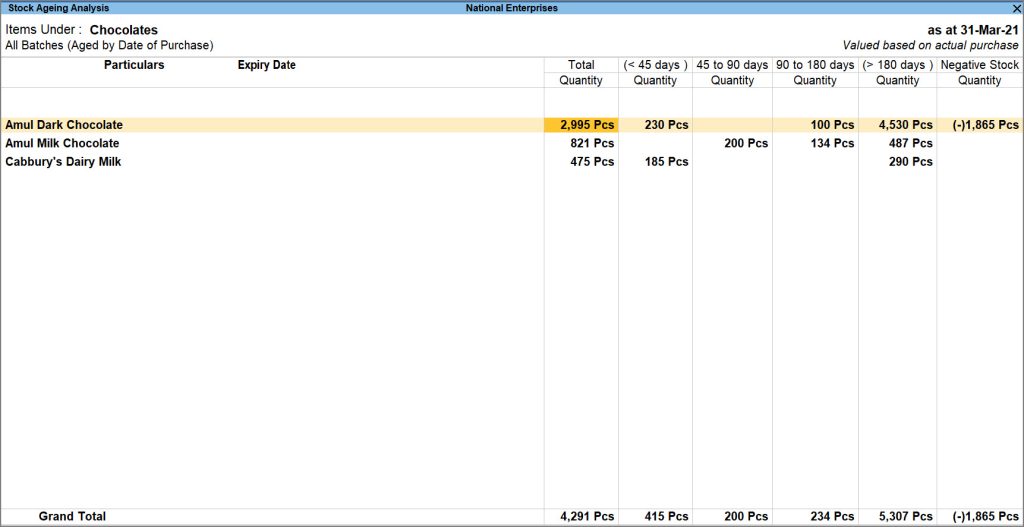
- Select a stock item and drill-down further.
The Stock Item Monthly Summary screen appears.
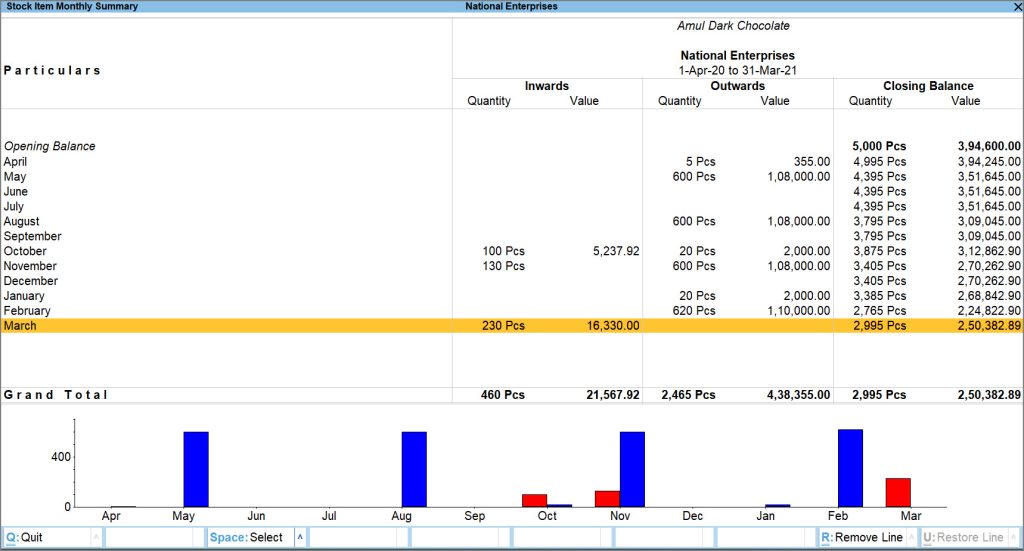
If you want to view the Stock Ageing Analysis for all the stock items in your company, select Primary from the List of Groups.
- Press F7 (Show Value) to include the Value column in the Stock Ageing Analysis report and display the Value of the stock item alongside the Quantity.
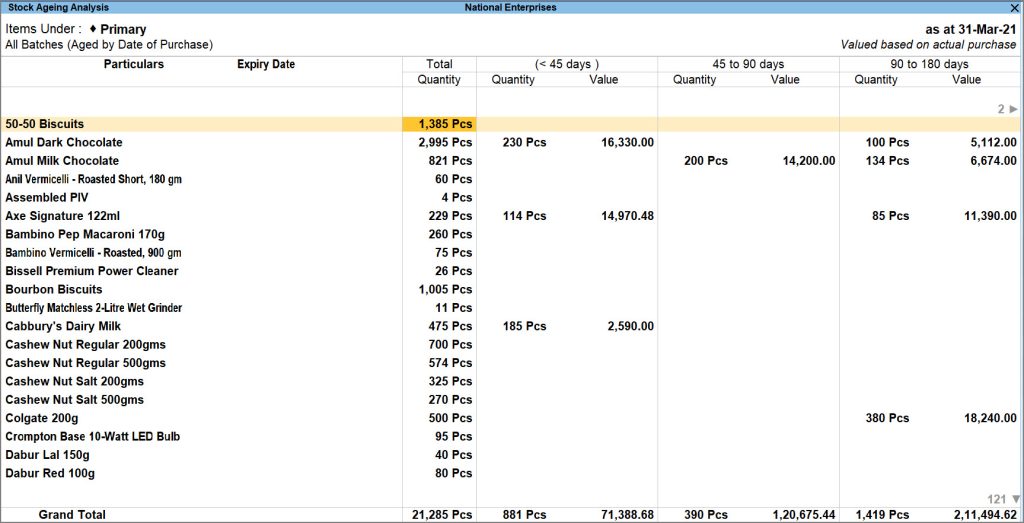
- Press F7 (Show Value) to include the Value column in the Stock Ageing Analysis report and display the Value of the stock item alongside the Quantity.
Varied configurations in the F12 (Configuration) screen in the Stock Ageing Analysis report allow you the flexibility of viewing your report as per your business needs.
- Format of Report: You can view the report in the condensed or detailed mode by selecting the required format in this option. Alt+F5 will also give you a detailed format of the analysis report.
- Display name for Stock Items: By default, all the stock items in the Stock Ageing Analysis are displayed according to the stock item name. However, you can change the way in which a stock item name is displayed in the report by selecting the required display names in the option.
- Sorting Method: By default, the stock items are alphabetically arranged in the report. You can sort the stock items in alphabetical (increasing or decreasing) order by selecting the required method.
Note: You will get the options Ageing Style and Expired Batches, only if you have activated Batch processing under F11 (Features). Set the options Enable batches and Maintain Expiry Dates for Batches to Yes.
Item Inwards Details
Age Analysis is done for stock-in-hand on the basis of its purchase date. The Item Inwards Details report provides further information of aged stock such as date of purchase and supplier and allows you to drill-down to the actual transaction voucher.
- On the Stock Ageing Analysis report, move the cursor to any of the age-wise columns (< 45 days, 45 to 90 Days, > 180 Days) for an item and press Enter.
The Item Inward Details screen appears as shown below:

You can drill down further and view the transaction voucher for the selected item.
F6 (Ageing Period): It offers you the flexibility of selecting the period to be displayed as the age slab for the stock items.
- Press F6 (Ageing Period)
The Stock Ageing Alteration screen appears wherein you can enter from and to which days you want to view the expiry dates. By default, the range for the days are 0-45, 45-90, 90- 180 and 180-0. However, you can enter the required number of days to be displayed in the age slab.
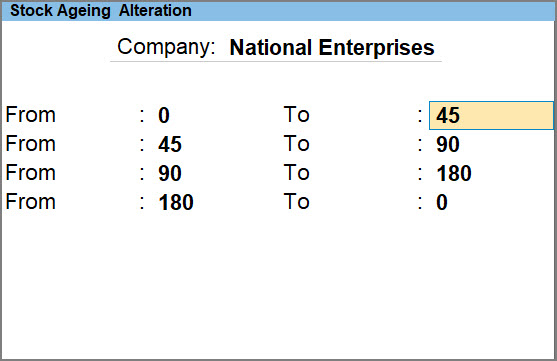
F4 (Stock Group): This will enable you to switch between stock groups while you are already in the Stock Ageing Analysis report.
Ctrl+H (Change View): You can change the view of the Stock Ageing Analysis depending on your business requirements. Various reports related to Stock Ageing Analysis such as Monthly Summary, Movement Analysis, Cost Analysis and Cost Estimates are also available in this section.
Ctrl+J (Exception Reports): You can view the Negative Stock Items in your company in this section.
To know more, refer toHow to Use Reports in TallyPrime | TallyHelp (tallysolutions.com)
View Stock Age with Valuation Method
Valuation of a stock item helps in determining its financial value at the given period. The value of any stock item either increases or decreases with time. Stock Ageing Analysis displays the stock items based on the valuation method that you select. It will help you in determining which batch of the items is valued more than the other and which valuation method of the stock item is adding more value to the available stock item. You can then decide which batch should be sold out at the earliest since its value is decreasing. It will also help you in deciding the best valuation method for your company.
Let us suppose that you want to analyse the value of stock-in-hand based on the monthly average cost of the items. To select the required Valuation Method,
- In the Stock Ageing Analysis, press F7 (Show Value)
- Press F8 (Valuation Method).
- From the List of Valuation Methods, you can select the required method.

To know more about varied valuation methods, click here.
The report is displayed based on the selected method.
You can view the Stock Ageing Analysis based on the Godown Type and Expired Batches if these options are enabled in the F11 (Features) screen.
To know more about working with Godowns, click here.
View Bills Age-wise
Bill-wise ageing analysis is done to identify the bills for which amount is due for a long period of time. These bills can be classified as bad debts or provisions can be created for such losses in the books of accounts depending on the results of ageing analysis. There are two methods to view the bills in age-wise format namely: Ageing by Due Date and Ageing by Bill Date. While passing a sales transaction, the due date entered while filling in the Bill-wise details indicates the credit days for the party to clear the payment. The payment should be made on or before the due date mentioned in the voucher. Based on the due date, you will be able to view the ageing of the bills. In this scenario, Ageing by Due Date method can be applied to view the report as per the due dates. In the absence of a due date, the bill date becomes the due date, and you can select Ageing by Bill Date and view the report accordingly. For sellers who do not provide credit to the buyers, this will be the best suited ageing method. In TallyPrime, the Stock Ageing Analysis can be applied on Ledger or Group Outstandings and Bills Receivables or Payables screens.
In this section
- Age-wise analysis of a single ledger account
- Age-wise analysis for a group
- Age-wise analysis for Bills Receivable/Payable report
Age-wise Analysis of a single ledger account
It might be possible that there are varied bills generated against a single party and you want to know which bill is aged more than the other. On selecting the ageing method, the report will be displayed based on the ageing dates of the bills.
- Press Alt+G (Go To) type or select Ledger Outstandings > and press Enter.
Alternatively, Gateway of Tally > Display More Reports > Statements of Accounts > Outstandings > Ledger. - Select the required ledger account.
- Press F6 (Ageing Method) > select the Ageing Method.

- Set the age periods required for the report.
The Ledger Outstandings report appears with the applied ageing method.
Age-wise Analysis for a Group
If you have sub-groups created as per the location of your debtors, then you can use this report for Age-wise analysis. Let us suppose you want to find out a group’s pending bills,
- Press Alt+G (Go To) > type or select Group Outstandings.
Alternatively, Gateway of Tally > Display More Reports> Statements of Accounts > Outstandings > Group. - Select a Group, for example Sundry Debtors.
- Press F6 (Ageing Method) > select the Ageing Method.
- Set the age periods required for the report.
The Group Outstandings report appears with the applied ageing method.
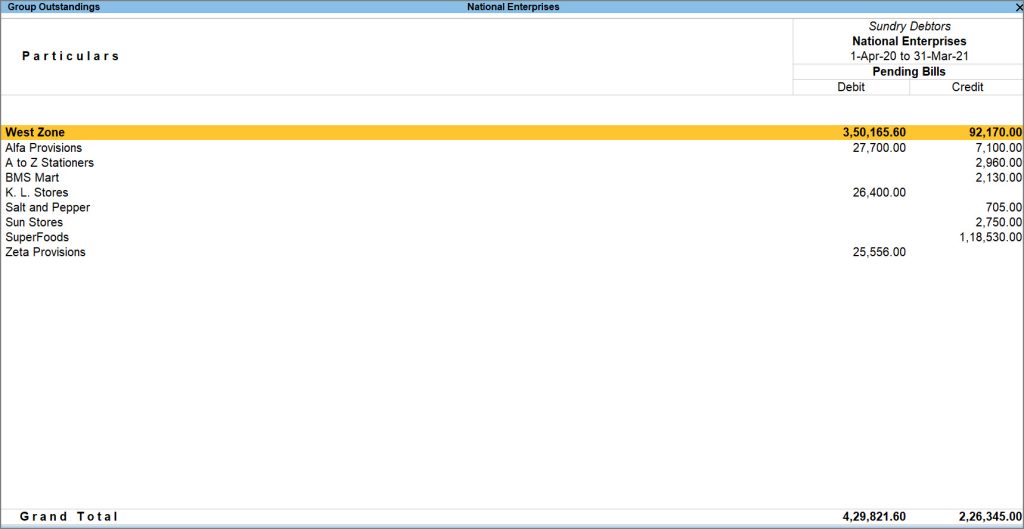
- In the F12 (Configure) screen, enable Show Nett Balances to view the nett balance of stock items under the selected group.
The Group Outstandings report displays the Age-wise Analysis for the selected Group.Note: You cannot print Reminder letters to a group from here. Use Multi-Account Printing available in Gateway of Tally to print the same.
Age-wise Analysis for Bills Receivable/Payable report
Irrespective of a ledger or groups, the ageing of all the pending bills in your company can be viewed using this report. Let us suppose you want to know how many bills are pending for ten days or more,
- Press Alt+G (Go To) > type or select Bills Receivable.
Alternatively, Gateway of Tally > Display More Reports > Statements of Accounts > Outstandings > Receivables. - Press F6 (Ageing Method)> select the Ageing Method.
- Set the age periods required for the report.
The Bills Receivable report appears with the applied ageing method.
View Stock based on Ageing Style
The Stock Ageing Analysis report gives you an insight into the age of the stock item based on varied ageing styles. You will be able to distinguish between batches of stock items that have already expired or are yet to be expired. The items can be listed based on the purchase date of the item or the manufacturing date. This report helps in managing the inventory and you can decide as to which item needs to be disposed of quicker, based on these ageing styles. With TallyPrime, you can view the Stock Ageing Analysis report based on four Ageing Styles namely, By Date of Purchase, By Expiry Date, By Mfg. Date and To be Expired. The stock items are displayed based on the selected Ageing Style. It is very useful for industries dealing with perishable goods where goods past the expiry date are of no value. Based on this information you can put out the items nearing expiry on sale and list them at a discounted price. The stock items are displayed in columns under which the expiry of the item is <10 days, 10- 15 days, 15-20 days and so on.
Let us suppose that you want to sell items from the batch which is going to expire in the next 10 days. You can display the stock items based on varied ageing styles to know how many days are left for that batch to expire. To select the required Ageing Style,
- Press Alt+G (Go To) > type or select Ageing Analysis > and press Enter.
Alternatively, Gateway of Tally > Display More Reports > Statement of Inventory > Ageing Analysis. - Select the Group for which Ageing Analysis is required.
- Press F9 (Ageing Style) to view the varied Ageing Styles and select the required style.

- Set the Show only Expired Batches option to Yes if you want to display only those batches which have already expired for the given period.
- By Date of Purchase: Displays stocks with batches in age-wise break-up on the basis of the Date of Purchase for the given period. By default, the Stock Ageing Analysis displays the stock items based on the date of when the item was purchased. The date when you purchased a particular item becomes the starting point and the last date of voucher entry becomes the end point in deciding the age of that stock item.
- By Expiry Date: Displays stocks with batches in age-wise break-up for all batches, on the basis of the date of expiry. For instance, if there are multiple batches of the one stock item or different stock items, filtering the report by selecting By Expiry Date as the Ageing style, will help you identify the expiry date of each batch.
- By Mfg. Date: This ageing style takes the manufacturing date of the stock item into account and displays the age-wise break-up accordingly. This will help you in identifying the batches that have been created recently or that are approaching expiry, on the basis of the ageing period (F6) and the reporting period (F2) set.
- To be Expired: Displays the age-wise break-up for batches that will expire in the future. The report will be displayed according to the expected expiry date of the stock item. Based on this information you can decide which batch of the stock item needs to be sold off at the earliest.
With Stock Ageing Analysis in TallyPrime, manage your business well and prevent your company from incurring loss due to expired stock item or depreciation of the stock item’s value by utilising these varied methods.



